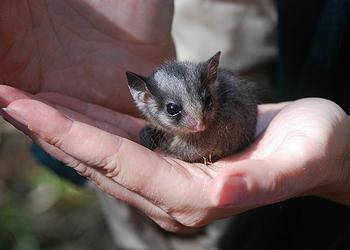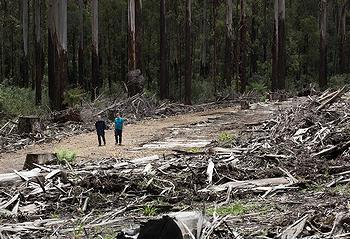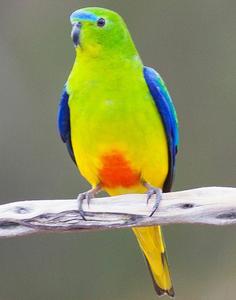Australia Scrambles to Rescue Vanishing Animals, Birds
MELBOURNE, Australia, July 20, 2015 (ENS) – The Australian government has set new targets to protect and recover threatened mammals, birds and plants, and improve recovery practices under the nation’s first Threatened Species Strategy.
At the Threatened Species Summit in Melbourne Thursday, Environment Minister Greg Hunt set out the new strategy.
“The Threatened Species Strategy sets out the government’s action plan to win the battle against extinction, commits $6.6 million to threatened species projects to kick-start that plan, and invites others with a shared passion for the bush and its wildlife to contribute as well,” said Hunt.

Juvenile male leadbeaters possum (Photo by Emma Campbell courtesy Greens MPs)
“Over time, plants and animals that once thrived on our continent have been pushed to the brink,” said Hunt. “We need to step in, for their sake and for ours.”
There is a lot that can be done, from limiting the impacts of feral cats and creating safe havens to improving habitat and intervening in emergencies. But no one can do it alone, so today’s summit brings together the people, organizations and know-how to drive change.
“By 2020, I am setting hard targets for real improvements to 20 mammals and 20 birds on our national threatened species list as well as for 30 priority plant species. That means humane culling of one of our wildlife’s worst enemies – feral cats,” said Hunt.
The first 10 mammals identified for priority action are: the numbat, mala, mountain pygmy-possum, greater bilby, golden bandicoot, brush-tailed rabbit-rat, eastern bettong, western quoll, Kangaroo Island dunnart and eastern barred bandicoot.
Two more – the leadbeater’s possum and central rock-rat – will benefit from emergency interventions.
The first 10 birds identified for priority action are: the helmeted honeyeater, hooded plover, eastern bristlebird, regent honeyeater, mallee emu-wren, plains-wanderer, night parrot, Alligator Rivers yellow chat, and Norfolk Island’s green parrot and boobook owl.
Two more – the orange-bellied parrot and western ground parrot – will benefit from emergency interventions.
The remaining eight species of mammals and eight species of birds will be identified over the next 12 months, in consultation with the community, said Hunt.
Part of the strategy is to cull domestic cats gone wild because they attack native birds and mammals. Since their arrival in Australia, feral cats have contributed to the extinction of at least 27 mammal species.
“By 2020, I want to see two million feral cats culled, five new islands and 10 new mainland safe havens free of feral cats, and control measures applied across 10 million hectares,” said Hunt.
Hunt released a threat abatement plan to limit the damage done by feral cats, after three months of public consultation on the draft document.
The feral cat culling projects are expected to benefit species as varied as bilbies in Queensland, central rock-rats in the Northern Territory, eastern barred bandicoots in Victoria and orange-bellied parrots in Tasmania.
But environmental groups say the government needs to do more to protect the habitats that endangered species need to survive.
If Environment Minister Hunt is serious about saving forest-dependent threatened species, he must act now to stop logging in their forest habitat, says the nonprofit Wilderness Society Australia.
“Iconic Australian species like the leadbeater’s possum and the swift parrot – found nowhere else on Earth – are at risk of extinction because of ongoing logging,” said Amelia Young, the Wilderness Society’s Victorian campaigns manager.
While Victoria’s leadbeater’s possum is at today’s summit to be listed for emergency intervention, state government logging continues in its forest habitat in the Central Highlands, just over an hour’s drive east of Melbourne.

Logging in a forest inhabited by the critically endangered leadbeater possum, Victoria, Australia (Photo courtesy Greens MPs)
“We expect that ‘emergency intervention’ means that urgent action will be taken to protect leadbeater’s possum habitat from logging,” said Young. “The onus is on the Federal Environment Minister and the responsible state Ministers to work together to prevent the extinction of this species.”
Young called on the ministers to to declare a Critical Habitat Determination at the Commonwealth level or an Interim Conservation Order at the state level in order to protect the forest habitat of these threatened species.
Not only is the Victorian animal emblem, the Leadbeater’s Possum, critically endangered, so is the Montane Ash forest ecosystem in which it lives.
“Strong Commonwealth laws are desperately needed to ensure that in the 21st century, animals like the Leadbeater’s Possum and Swift Parrot don’t go the way of the Tasmanian Tiger,” said Young.
The Australian Conservation Foundation, BirdLife Australia and Environmental Justice Australia released a report earlier this month showing that recovery plans for Australia’s most endangered species are failing to protect habitat.
Released ahead of the first national Threatened Species Summit, the report finds that of Australia’s 120 most endangered animals, only 10 percent had plans that placed any clear limits on the future loss of habitat.
“Threatened Species Recovery Plans, developed under the EPBC Act, are the Federal Government’s key instrument for bringing threatened species back from the brink of extinction,” said James Trezise, a policy coordinator for the Australian Conservation Foundation.
Habitat destruction is one of the major drivers for threatened species decline.
“Extinction is a choice. Where we have tried in the past, Australia has been remarkably successful at recovering threatened species. In many cases averting extinction has been straightforward and relatively inexpensive,” said Samantha Vine, head of conservation at BirdLife Australia.
Vine said, “It is essential that Australia make protecting endangered species habitat a key focus in combating the current extinction crisis.”
Copyright Environment News Service (ENS) 2015. All rights reserved.
http://ens-newswire.com/2015/07/20/australia-scrambles-to-rescue-vanishing-animals-birds/
